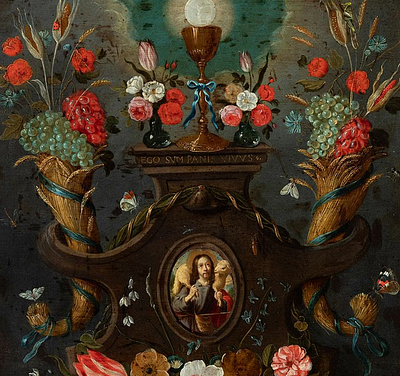Spanish school, follower of EL GRECO DOMENIKOS THEOTOKOPOULOS (Candia, Greece, 1541 - Toledo, 1614); 17th century. "The Veil of Veronica". Oil on ca
Lot 33
About Seller
Setdart Auction House
Carrer Aragó 346
Barcelona
Spain
Setdart Subastas was born in 2004 and is currently the first online art auction in Spain with solidity, prestige and reliability guaranteed by our more than 60,000 users. Setdart has a young, dynamic and enterprising team ready to successfully manage the purchase and sale of art works through custom...Read more
Estimate:
EUR€1,500 - EUR€2,000
$1,578.95 - $2,105.26
Absentee vs Live bid
Two ways to bid:
- Leave a max absentee bid and the platform will bid on your behalf up to your maximum bid during the live auction.
- Bid live during the auction and your bids will be submitted real-time to the auctioneer.
Bid Increments
| Price | Bid Increment |
|---|---|
| EUR€0 | EUR€10 |
| EUR€200 | EUR€25 |
| EUR€500 | EUR€50 |
| EUR€1,000 | EUR€100 |
| EUR€3,000 | EUR€200 |
| EUR€5,000 | EUR€500 |
| EUR€10,000 | EUR€1,000 |
| EUR€20,000 | EUR€2,000 |
| EUR€50,000 | EUR€5,000 |
About Auction
By Setdart Auction House
Sep 21, 2021
Set Reminder
2021-09-21 10:00:00
2021-09-21 10:00:00
America/New_York
Bidsquare
Bidsquare : 21st September - ARAS JÁUREGUI Private Collection - Old Masters, 19th & 20th Century
https://www.bidsquare.com/auctions/setdart-auction-house/21st-september---aras-j-uregui-private-collection---old-masters-19th-20th-century-7429
Setdart Auction House sofia@setdart.com
Setdart Auction House sofia@setdart.com
- Lot Description
Spanish school, follower of EL GRECO DOMENIKOS THEOTOKOPOULOS (Candia, Greece, 1541 - Toledo, 1614); 17th century. "The Veil of Veronica". Oil on canvas. Re-coloured. Dirt. Imperfect, and lost. Measurements: 68 x 68 cm. The scene represented here, which would later give rise to the iconography of the Santa Faz, typical of devotional painting, is an episode that occurred during the Passion of Christ. Exhausted by the blood lost in the scourging, weakened by the physical and moral suffering inflicted on him the night before, and without having slept, Jesus was barely able to take a few steps and soon fell under the weight of the cross. Then followed the blows and imprecations of the soldiers, the expectant laughter of the crowd. Jesus, with all the strength of his will and with all his strength, managed to get up and continue on his way. According to theological interpretations, Jesus invites us by his actions to carry our cross and to follow him, he teaches us that we too can fall, and that we must understand those who fall; that none of us must remain prostrate, we must all get up with humility and trust, seeking his help and forgiveness. The scene depicted here is the result of the specific moment when, on the way to Calvary, a woman took off her veil to wipe the face of the Messiah with it. The image of the face of Jesus Christ was imprinted on the linen handkerchief, and it was miraculously preserved through the centuries and became an object of worship. The woman would later be called Veronica, whose etymology derives from the Latin "verum" (true) and the Greek "eikon" (image). In the present work we can appreciate several of the identifying aspects of El Greco's style, those that endowed his work with a totally personal character. El Greco acquired his personal palette during his stay in Venice between 1567 and 1570. From then on he would acquire a lively and prominent colour, as well as a loose and agile brushstroke. It is an artificial colour, totally anti-classical and mannerist, purely conceptual. His tones are intensely lightened by the light, especially his metallic greys, which are very elaborate and changeable, as we see here in the background and on the face of the figure. El Greco's style was fully Mannerist, hence the lengthening of the canon, which reaches twelve heads, and the twisting of the anatomies, which are very expressive and can even verge on deformity, albeit based on his knowledge of classical statuary.
- Shipping Info
-
In-house shipping available. Please inquire at admin@setdart.com.
-
- Buyer's Premium



 EUR
EUR CAD
CAD AUD
AUD GBP
GBP MXN
MXN HKD
HKD CNY
CNY MYR
MYR SEK
SEK SGD
SGD CHF
CHF THB
THB















